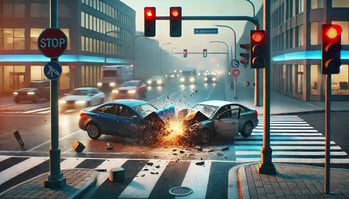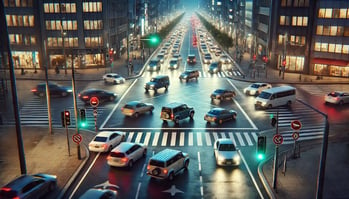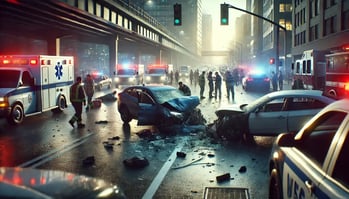Understanding Fault in Yellow Light Accidents
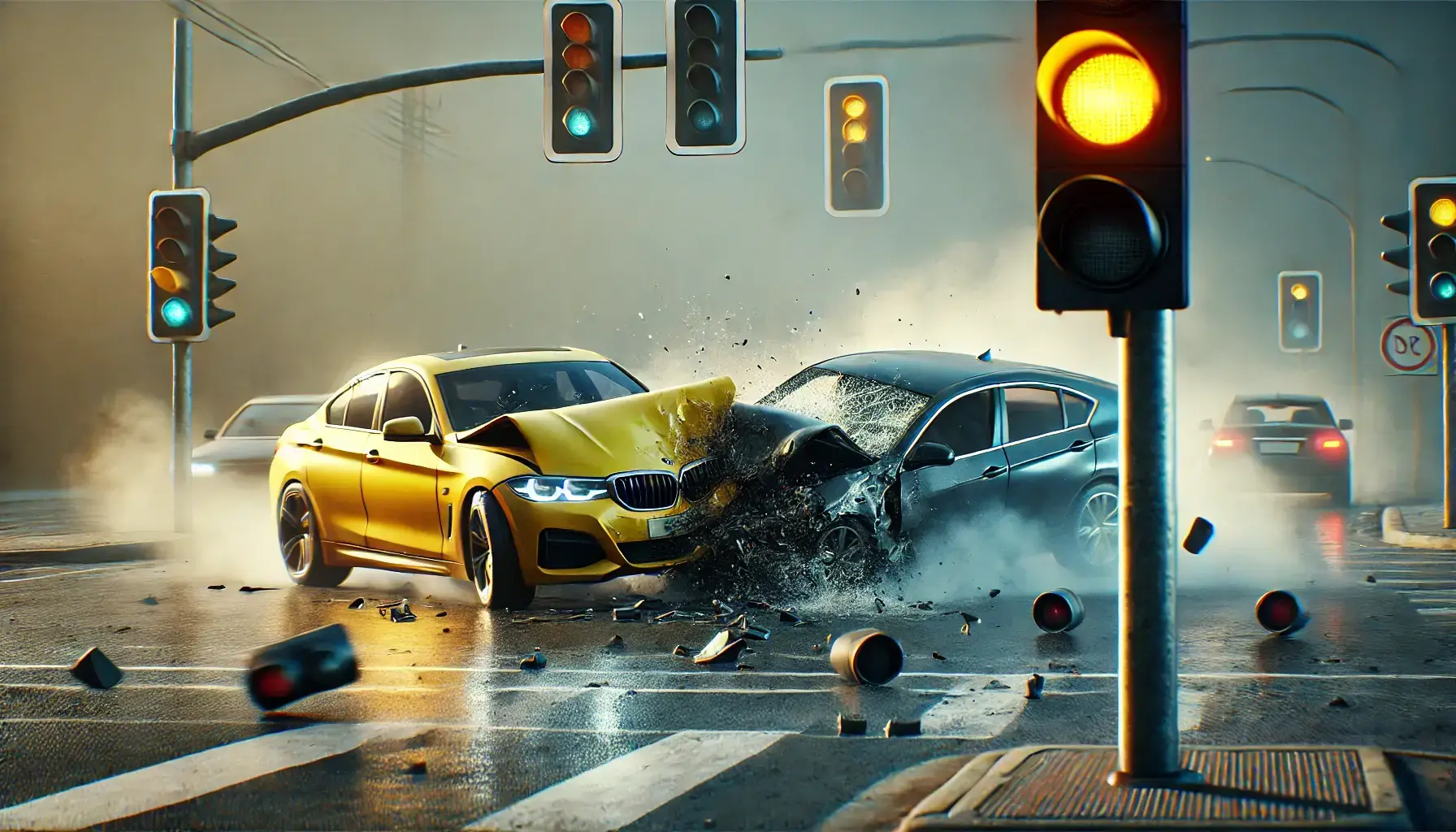
Legally reviewed by:
Daniel Smith August 22, 2024
Most of the time, traffic lights give clear instructions. Red means stop, and green means go. However, yellow lights are transitory, telling drivers to prepare to stop but not asking them to stop entirely.
The yellow light is therefore slightly ambiguous, and different drivers could react to it differently. When one driver does the opposite of what another driver believes to be the appropriate thing, it confuses, and could lead to accidents.
Due to the confusion in yellow light accidents, it could be challenging to determine fault because both drivers would likely believe their actions were appropriate in the situation. This makes yellow light accidents one of the most complex car accidents to untangle.
But ultimately, understanding fault in these accidents is vital for insurance purposes. It is also important if any parties intend to take legal action against the other(s) for damages.
In this article, we cover everything you need to know about yellow light accidents including best practices, legal options, and the legal framework surrounding them.
What Causes Yellow Light Accidents?
When the yellow light comes up, here are the things most likely to cause an accident:
Driver behaviour at yellow lights
The primary cause of any yellow light accident is the driver's behaviour. Drivers who show no regard for traffic rules and the safety of other drivers are most likely to cause yellow-light accidents.
Misjudging stopping distance
Rear-end accidents are quite common at yellow lights, and they often happen because one or more drivers have misjudged the stopping distance or point. At busy intersections, some drivers follow the preceding car very closely, leaving very little distance to react to sudden stops.
With this little distance, if the preceding driver immediately stops when the light turns yellow, while the following driver expects them to keep moving because it is only a yellow light, an accident is likely. The probability of an accident increases if the preceding driver decides to stop after crossing the stop line, and many drivers do stop after crossing the stop line.
Pressure to beat the red light
Drivers eager to cross traffic before the light turns red are another major cause of yellow light accidents. These drivers often cross intersections after the traffic light supposed to control their side of the traffic has been yellow for some seconds. By the time they are in the middle of the intersection, oncoming traffic has likely seen green and that could lead to a collision.
Confusion about right-of-way
Drivers unsure of the right-of-way rules in their jurisdiction could also find themselves in yellow light accidents. Even though the traffic lights at intersections mostly determine who is to stop and who is to move, in grey area situations (like with yellow lights), knowing when you have the right to move and when you should yield is important.
One driver who believes they should be moving and an oncoming driver who thinks the first driver should yield is a recipe for accidents.
Distracted driving
Drivers who text while driving, fiddle with controls while moving, or engage in distracted driving are also likely to cause yellow light accidents. If a driver does not have most of their attention on the road or the traffic lights, they may unconsciously proceed into an intersection when the light is yellow, believing it to be green.
If such driver falsely believes all other sides of the intersection are not moving before entering it, and they encounter oncoming traffic, they'll likely be too surprised or frightened to respond safely.
The Legal Framework of Yellow Light Accidents
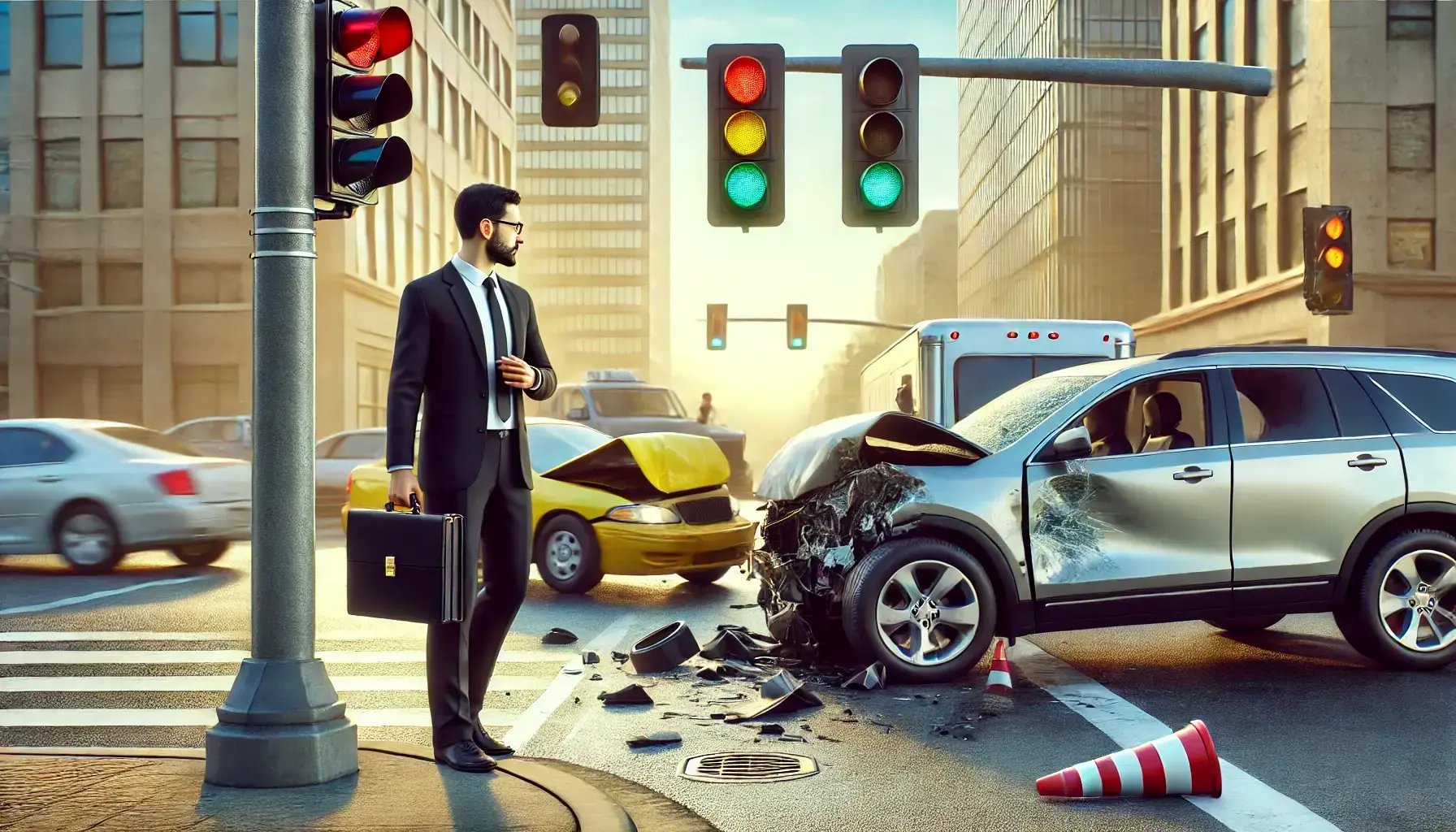
What is the legal position on yellow lights and yellow light accidents?
Traffic laws regarding yellow lights
The traffic laws regarding yellow lights primarily surround what a driver’s reaction to yellow lights should be and whether you should enter an intersection after a light turns yellow. Many times, these traffic laws also detail the legal consequences for breaking any of those laws.
However, the general traffic rule on yellow lights is that moving on a yellow light will not constitute a crime if stopping at that point is unsafe.
Variations in state laws
Naturally, slight differences persist in state law on yellow lights. An example: Georgia law (Ga. Code § 40-6-21) states that a circular yellow or yellow arrow warns vehicles that movement is being terminated, and a red indication that will forbid cars from entering the intersection is coming up.
It also provides that a flashing yellow arrow will allow vehicles to proceed in the direction of the arrow, as long as they yield the right of way to oncoming vehicles when turning.
Meanwhile in New Jersey, N.J. Rev. Stat. § 39:4-105 provides that a yellow light means traffic should stop before entering the intersection except when the vehicle is so close to the intersection that it cannot safely stop.
It also specifies that fifty feet from the intersection is considered a safe stopping distance for a vehicle moving at twenty miles per hour.
The penalties for violating yellow light laws also vary across states. In Delaware, under Del. Code tit. 21, § 4101, failure to comply with a traffic light signal will result in a fine not exceeding $110 to be paid within 20 days.
But in Florida, violation of a yellow traffic light law is a noncriminal traffic infraction punishable as a moving violation (Fla. Stat. § 316.075 (4)) with a fine specified under Fla. Stat. § 318.018.
The concept of “permissive yellow” vs. “restrictive yellow”
The most notable difference between states' substantive law regarding yellow lights revolves around permissive yellow v. restrictive yellow. Most states currently adopt the permissive principle, and only a few use the restrictive.
Permissive yellow law allows drivers to enter the intersection while the light is yellow, provided it is safe to enter. Georgia (law discussed above) is an example of a permissive yellow state.
Another example is Ohio, where Ohio Rev. Code § 4511.13 provides that a steady yellow is a warning that a steady red will soon be displayed, and a flashing yellow permits a cautious entrance into the intersection.
The restrictive yellow principle, on the other hand, requires drivers to stop at a yellow light unless it is not safe to do so. In restrictive states, drivers should only enter an intersection on a yellow if they can clear the crossing before the light turns red. Apart from New Jersey (discussed above), another state that practices the restrictive yellow is Virginia under Va. Code § 46.2-833.
Legal definitions of right-of-way at intersections
A right-of-way refers to the legal entitlement to proceed at a particular point. Any driver who does not have the right to move at that point is expected to yield the road to a driver with the right. The legal provisions on right-of-way may vary slightly by state, but there are a few common and general principles.
At uncontrolled intersections, the first vehicle to arrive has the right-of-way. However, if two cars arrive at the same time, the vehicle to the right will possess the right-of-way since the US is a right-hand traffic country.
At controlled intersections, the traffic light determines who has the right of way. Anytime a driver turns left in an intersection, they must yield to oncoming traffic except the traffic light explicitly grants the turning driver the right.
Determining Fault in Yellow Light Accidents
So, what are all the elements that influence fault determination in yellow light accidents?
Factors considered in fault determination
Since these accidents can be very tricky, a couple of factors are considered before fault is apportioned:
- The Driver’s actions are naturally the biggest determiner of fault in these instances. Their reaction to situations and whether they broke traffic laws will significantly contribute to fault. However, the driver's intentions will also be considered.
- The position of the vehicles involved in the collision is also considered sometimes. For instance, if a driver from oncoming traffic collides with another driver just as the second driver is about to clear the intersection, it may be determined that even though the second driver was at fault, the driver from oncoming traffic could have reasonably avoided the accident.
- Right-of-way is also a big determiner of fault. If a person who is supposed to yield fails, chances are, they will be considered responsible.
Role of traffic cameras and witnesses
Traffic cameras and witnesses play a key role in ascertaining a driver’s actions which we've established as the key fault determiner. Cameras can provide information on whether a driver was going over the speed limit or was distracted. Witnesses may also be providing such key details where there are no cameras.
Importance of police reports
Obtaining police reports for such complex accidents is essential for successful insurance claims. This will document information like the position of the vehicles, the angles at which the collision occurred, and whether any of the drivers were driving under the influence of a substance. A police report will also likely record who the investigating officer believed to be responsible for the accident.
Impact of local traffic laws on fault
Local traffic laws also contribute to how fault is determined to an extent. For instance, a driver who crosses into an intersection and is involved in an accident in a state that practices the restrictive yellow principle is more likely to be found at fault than a driver who does so in a state practicing the permissive yellow.
Shared fault scenarios
For certain yellow light accidents, more than one party will be held responsible. A good example will be when a driver stops at a yellow even though it is reasonably unsafe to do so, but they are only rear-ended because the following driver did not maintain a safe stopping distance.
Legal Consequences of Yellow Light Accidents
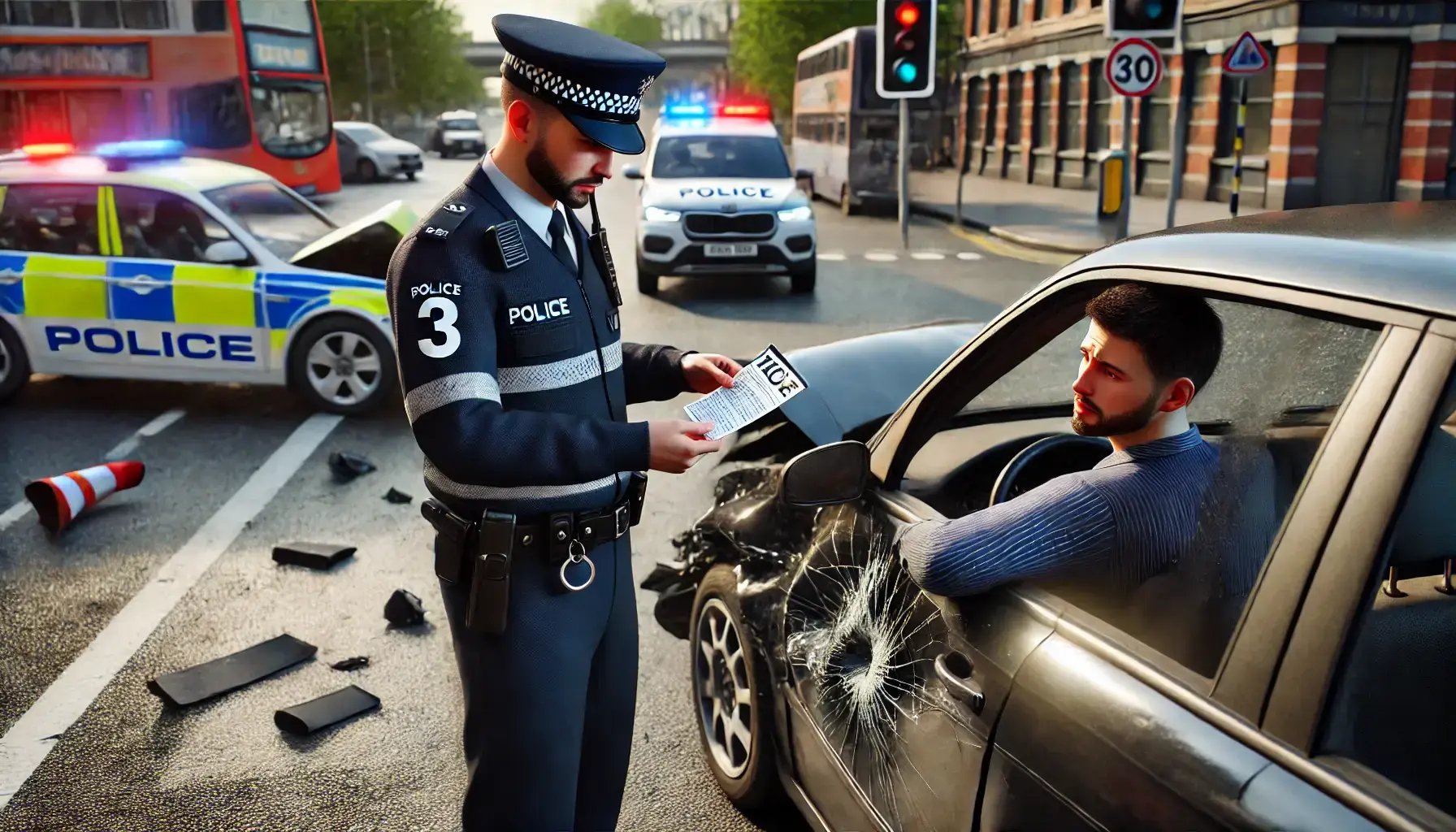
Once fault has been determined, what are the legal consequences for the responsible driver in a yellow light accident?
Traffic citations and fines
Citations (tickets) and fines are the most common legal consequences for minor yellow light traffic violations and accidents. Most times, the fine will be determined by the city, and in certain instances, it may be regulated by state law.
Potential criminal charge in severe cases
Where a yellow light accident results in severe injury, significant property damage, or death, it could result in a criminal charge. This is even more likely when the driver is found guilty of another traffic violation like DUI.
In Washington, vehicular homicide is a class A felony according to Wash. Rev. Code § 46.61.520, and a driver will be guilty if they operated a vehicle in a reckless manner or without regard for the safety of others. A yellow light accident can, to an extent, evidence the operation of a vehicle in a reckless manner or zero regard for the safety of others.
Civil liability and damages
Depending on the state’s insurance and negligence laws, a driver may face a lawsuit from a person who has suffered injuries or damages in a yellow light accident for which the driver is responsible.
The person suing will have to prove the driver’s fault in court. If a jury agrees that such a driver is responsible for the accident, they become financially liable to the person for the monetary amount of damages granted to the person by the jury.
Impact on driving record and insurance rates
Although, not entirely a legal consequence, yellow light accidents (and traffic violations generally) negatively affect driving records. If a driver commits up to a specified level of infractions in a year, their license will be suspended.
Insurance companies then rely on that driver’s driving record to determine their rates. If an insurer believes a driver is high-risk because they are regular traffic offenders, they will be charged higher premiums to get insurance.
Your Legal Options
What are your legally available options in response to being involved in a yellow light accident?
Filing an insurance claim
You could file a first or third-party insurance claim to cover any injury or property damages incurred in an accident. It is important to note that proving fault is key to the success of any third-party claim.
Pursuing a personal injury lawsuit
Depending on whether the accident occurred in a fault-based state or a no-fault state, you can file directly to sue or sue if your medical expenses exceed the state-required minimum PIP limit respectively. Naturally, you can also pursue a lawsuit for property damage.
Seeking legal representation
Legal representation is essential to guarantee success if you need to respond to being in a yellow light accident. Whether you have suffered damages or were responsible for the accident and need to present your defense, an attorney can effectively represent you in court or help you negotiate with insurance companies.
Statute of limitations considerations
Whatever options you choose, it is important to be conscious of the statute of limitations on personal injury lawsuits in your state.
Since insurance companies largely attempt to limit their customer's exposure to a lawsuit, they will likely not give much thought to your third-party claim once the period provided by the statute expires. You will also be unable to institute legal action after the period expires.
Preventive Measures and Best Practices
How can you prevent yellow light accidents? It is best practice to adopt defensive driving techniques. Some of them are:
Understanding the “dilemma zone”
The dilemma zone refers to the intersection area where it is no longer possible to stop safely because the light has turned yellow, but you cannot also clear the intersection before the light turns red. Drivers will have different dilemma zones depending on their age, aggressiveness, and expertise.
If you find yourself in a dilemma zone, it is important to remember that it is not your fault. Poorly designed roads are more likely to cause dilemma zones. Some other things you should do are:
- Remain calm.
- Do not abruptly stop.
- Do not floor the gas pedal thoughtlessly.
- Scan the area and evaluate the distance between you and oncoming traffic.
- Increase your speed accordingly to clear the intersection.
To avoid getting into the dilemma zone often, maintain the speed limit before crossing intersections.
Proper use of turn signals
Your turn signals are indispensable when crossing intersections. And if there are lane-use arrows on the road, be sure to follow them.
Maintaining safe following distances
Understand your car's stopping distance at different speeds, and maintain enough space to safely stop at your speed if the vehicle ahead of you stops abruptly.
Staying alert and avoiding distractions
Staying focused and alert before crossing an intersection is essential to prevent a yellow light accident. While you keep an eye on the traffic lights, you also need to remain aware of the car ahead of you while still scanning the intersection before you cross.
Contact The Accident Helpers Today
Yellow lights are in-between moments, and as a result, there's often no clear distinction on whether a person was right or wrong with these accidents. However, right-of-way rules, the angle at which the collision occurs, and the driver's actions help insurance companies and juries determine responsibility for yellow light accidents.
Understanding who is likely to be at fault for any such accident also helps you understand what you ought to do, or what you are entitled to if you are ever in a yellow light accident.
However since these accidents can be so complex to untangle and require significant investigation into their exact causes, it is best to have a lawyer to help you with any challenges you face.
At The Accident Helpers, we can assist you with getting the best yellow light accident lawyers around you. Interested in seeing how? Book a free consultation with us today and let’s get started!


